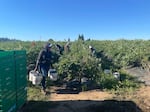Skyler Fischer is forklift driver at a Fred Meyer distribution center in the town of Clackamas. He’s been working there for 12 years and works at least four days a week, 10 to 12 hours each day. Fischer said he gets two 15-minute breaks each shift.
On Tuesday, when temperatures soared to 102 degrees Fahrenheit in the Portland metro area, Fischer said he was drained. He said the warehouse has no air conditioning, no ceiling fans or any type of air circulation in the building. He said the only time he can cool down is during his lunch break when he gets to eat inside an air-conditioned office.
“Usually, I get home and I do stuff, but I just collapsed on the couch pretty much because I’m so exhausted,” he said.
In May, the Oregon Occupational Safety and Health Division adopted permanent rules to protect workers laboring in excessive heat or wildfire smoke. They are some of the nation’s strongest protections for employees working outdoors or in workplaces without air conditioning.
But this week, with daily highs consistently hitting triple-digits, is putting Oregon OSHA’s recently implemented heat rules to the test. Some Oregonians have said they’re still laboring in unsafe conditions despite the new heat rules.
The rules went into effect last month and apply when temperatures in a work environment reach 80 degrees Fahrenheit. They require employers to provide access to shaded areas, cool drinking water, and additional rest breaks to cool down and acclimate to the heat. The rule also requires employers to provide heat illness prevention training.
Fischer said he and his co-workers have not seen these changes in their workplace even after pointing out the law to their employer. He said it’s made him dread going into work.
“You kind of lose hope,” the 32-year-old said. “You got to go in there and get your paycheck or else your family isn’t going to be fed. So you go in there begrudgingly every day.”
Aaron Corvin, Oregon OSHA’s public information officer, said the agency has opened an inspection related to the Fred Meyer facility.
A statement from Fred Meyer said the company has installed a mechanical cooling station at its 1-million-square-foot warehouse in Clackamas. On days with high temperatures, the company provides employees with access to water bottles on ice, water fountains, frozen treats and cooling towels. A distribution team also takes daily temperatures throughout the facility and said this week temperatures have not exceeded 80 degrees Fahrenheit, the statement said.
Dozens of heat-related workplace complaints
Last summer, the Pacific Northwest experienced a heat dome event in which nearly 100 people died from heat-related illness in Oregon alone. At least four of those happened on the job and were reported by Oregon OSHA.
That included a farmworker who collapsed and died on a farm north of Salem and a construction worker who became ill while inspecting a roof in Hillsboro, went to a hospital and died nine days later.
Shortly after the first workplace death was reported, several labor rights groups and environmental organizations called on Gov. Kate Brown to take action and direct Oregon OSHA to issue temporary heat rules to protect workers. The agency has since adopted those rules permanently after more than a year and a half of rulemaking.
That process lays out the expectations for employers and their obligations to protect workers against the dangers of extreme heat, Oregon OSHA’s Corvin said.
He said that since the rules took effect on June 15, there have been at least 137 open inspections that relate to work hazards and heat complaints. Oregon OSHA has thus far issued nine citations for not following heat rules.
“I would certainly expect that we will have more,” Corvin said.
Most of the inspections currently underway involve the restaurant industry, warehouse workplaces and construction sites. A citation or violation can lead to a fine.

Visible smog blankets Portland, Ore., on July 26, 2022. The city broke an all-time heat record for the date when the temperature hit 102 degrees.
Kristyna Wentz-Graff / OPB
Corvin said more than half of the heat-related complaints the agency has received the past two weeks came on July 26 and 27, days on which temperatures reached triple digits.
“We’ve got multiple citations pending, we have multiple inspections that are being opened as we speak,” he said. “So this is something that we’re engaging on and we’re spending extra time in the field to do it.”
Corvin said the agency has 85 compliance officers. Most go out to inspect workplaces and can handle multiple cases at once. Sometimes, more than one compliance officer is sent to inspect a complaint.
But even though there has been an increase of compliance officers in the field, some say the rules aren’t being applied at all in some locations.
More clarity
Pineros Y Campesinos Unidos del Noroeste, known as PCUN, along with other labor rights groups and environmental groups, has been advocating for rules like these for years.
PCUN’s climate policy associate Ira Cuello-Martinez said, for the most part, PCUN is hearing from its members that employers are following the new rules. Some even go beyond what is required like providing salty crackers and electrolyte drinks to help with maintaining hydration and encourage extra breaks.
But Cuello-Martinez has also heard from farmworkers that some employers aren’t applying any of the rules.
“Some workers were unaware of the rule even being in effect and have not received any sort of training from their employers when it comes to excessive heat,” he said.

Farmworkers preparing blueberries they picked in Albany, Ore., in June 2021. A farmworker elsewhere was among dozens who died in an extreme heat wave that year.
Monica Samayoa / OPB
Under the new rules, workers should be receiving training in language they understand about the dangers of working in extreme heat conditions, Cuello-Martinez said. He said it’s unclear whether employers are providing flyers, allowing employees to ask questions or giving them time to digest the new information.
Another issue farmworkers face is understanding how the acclimation breaks work, Cuello-Martinez said. Employers can develop preventative cool-down rest breaks from three options Oregon OSHA provided in the rules. But Cuello-Martinez said that creates a lot of confusion for farmworkers who work in several different locations.
And while the rules are in place to protect workers from heat-related illnesses, that is also leading to loss of work, Cuello-Martinez said. He’s heard that some farmers end the work day earlier when temperatures get too high and that’s affecting the farmworkers’ income.
“While they understand the health aspects of not working in those conditions, they don’t have any other source of income,” he said. “It does get stressful for them.”
‘There’s always room for improvement’
Meanwhile, several business organizations criticized the new rules, saying they’re not helpful to employers or employees. Three groups — Oregon Manufacturers and Commerce, Associated Oregon Loggers Inc. and the Oregon Forest Industries Council — even sued the state in June to try to prevent the rules from taking effect.
Mary Anne Cooper, vice president of government and legal affairs for the Oregon Farm Bureau said the rules are overly prescriptive and they’ve caused confusion for farmers, ranchers and farmworkers.
New documentation and reporting requirements also provide logistical challenges to some smaller family farms, Cooper added.
“It’s just been a real challenge this year for our employers to meet these pretty burdensome new rules while maintaining a workforce and keeping their employees happy,” Cooper said.
Farmers have told the bureau, which represents some 6,700 Oregon farms, that they’ve been fielding questions from workers about what kind of clothing they can wear, when and where they can and cannot take breaks, and why shifts are ending early when it’s hot outside.
Cooper said she worries the new rules could sow distrust among some farmworkers and discourage them from coming back to work in Oregon in the future.
“Our members care deeply about their workforce,” she said. “I think for us it has always been about finding what is the right balance between understanding that the state has to make sure that the workforce is protected while honoring the autonomy and desires and needs of the workforce.”
Oregon OSHA’s Corvin said the agency is heavily focused on carrying out and enforcing the rules and providing educational information to employees so they know their rights. He said they are committed to optimizing the rules as “there’s always room for improvement.”
Federal workers short of protections
The state’s new rules don’t apply to all people working outside in Oregon, leaving people like Willie Groshell with limited options.
Groshell started his Northeast Portland delivery route Tuesday morning at 7:15 a.m. By the time he clocked out at 8 p.m., his pedometer recorded nearly 34,000 steps on a day when temperatures reached 102 degrees Fahrenheit.
He’s been working as a letter carrier for the U.S. Postal Service for more than 17 years and he’s the president of the Oregon State Association of Letter Carriers.
When temperatures reach triple digits for multiple days, he said that usually means he can’t get any real rest even when he’s off the clock.
“I have to make sure that I drink excessive amounts of water tonight to the point that I know I’m going to wake up in the middle of the night and have to go to the bathroom,” he said. “Because if I don’t get to that point of hydration, I’m already going to be in trouble at the start of the next day.”

A mail carrier delivers items on July 28, 2022, in Southwest Portland as temperatures soared past 100 degrees Fahrenheit.
Kristyna Wentz-Graff / OPB
Groshell said he has to be intentional about what he eats and how he cares for himself when there is a heat wave. For example, his lunch consists of watery foods, like raw cucumbers, celery, radishes, and carrots, to help him stay hydrated throughout the day and avoid heat-related illnesses.
Because his job requires him to be outdoors, there are limited places where Groshell can find reprieve. Extreme heat has led to dozens of hospitalizations and several deaths of mail carriers and delivery workers in recent years.
“Ten years ago letter carriers didn’t die,” he said. “But for the past 10 years it seems like every single year somewhere in this country we’ve had at least one if not more than one letter carrier die from heat exposure.”
Last year, the Biden administration pledged to begin developing federal rules to protect workers from heat-related illnesses after extreme heat left dozens of workers injured or dead.
Currently, Washington and California have temporary rules for protecting workers and are developing permanent rules. Workers in other states are protected through the federal Occupational Safety and Health Administration’s General Duty Clause, which requires employers to provide a place of employment “free from recognized hazards that are causing or likely to cause death or serious harm to employees.”
Groshell said he hopes other states pass laws similar to Oregon’s, so that it forces the federal government to adopt stronger regulations.
“Or the other way that it’s going to happen is we’re going to have more and more people die,” he said.
